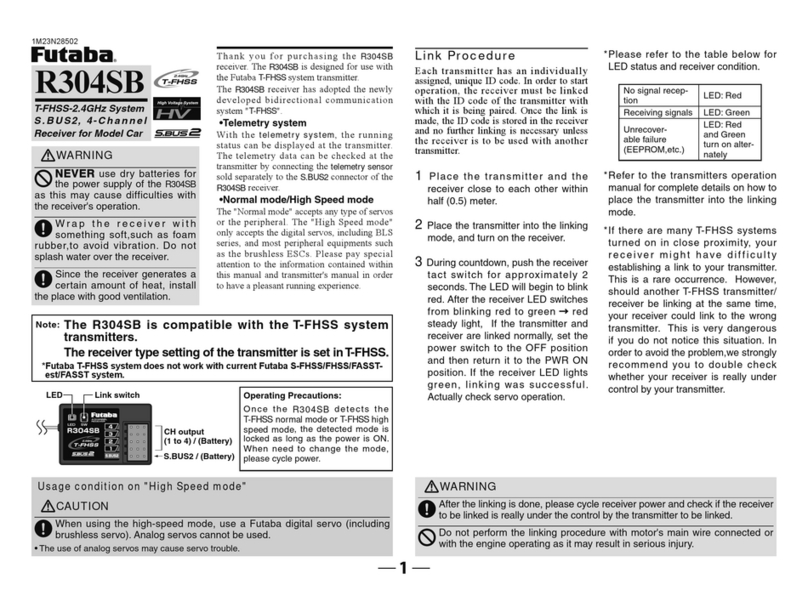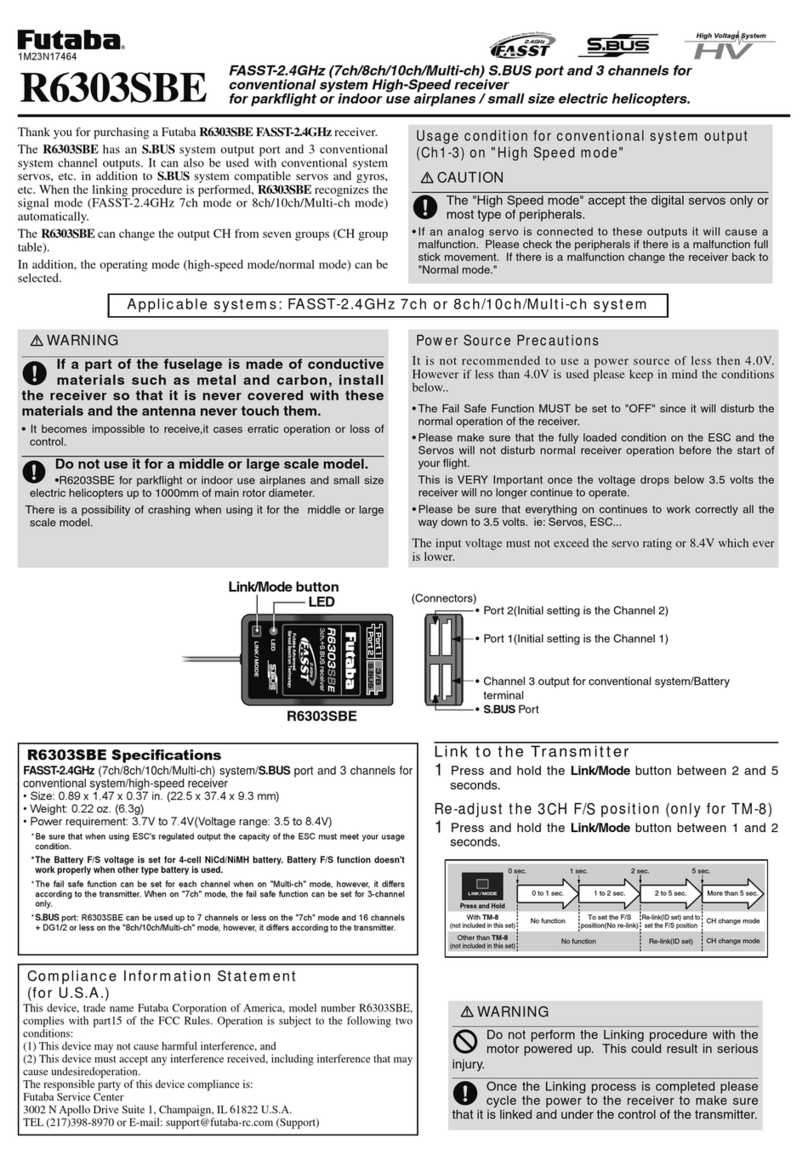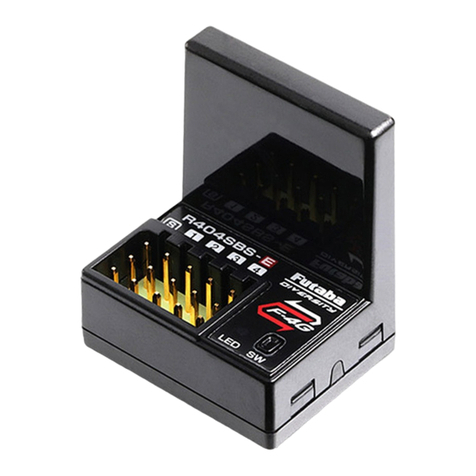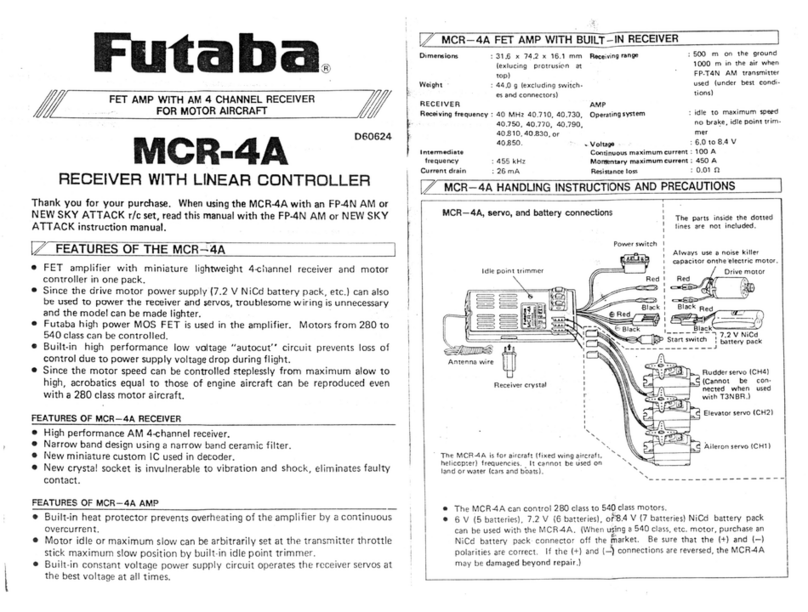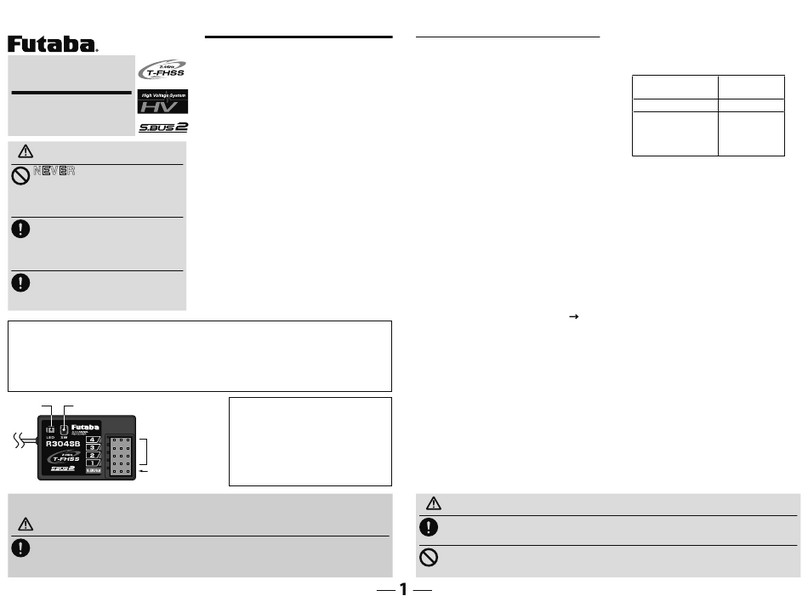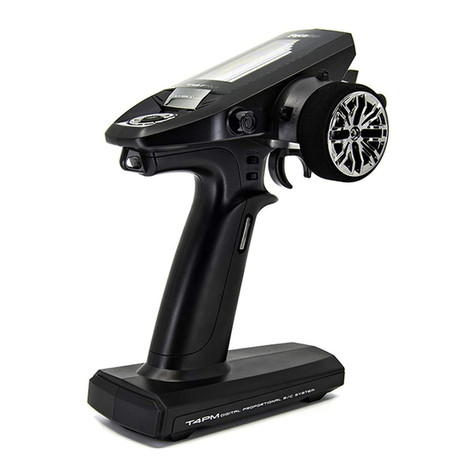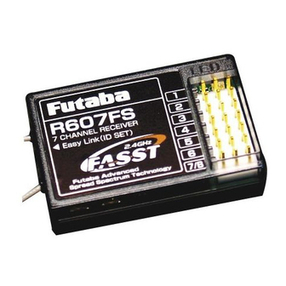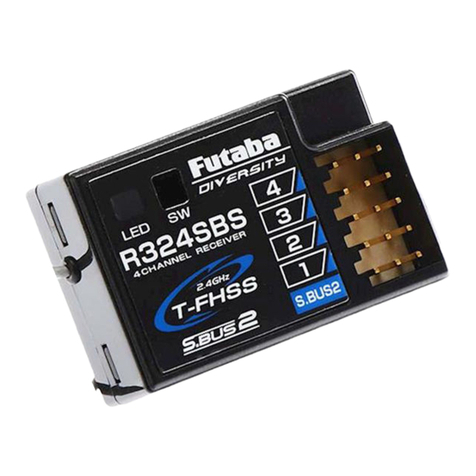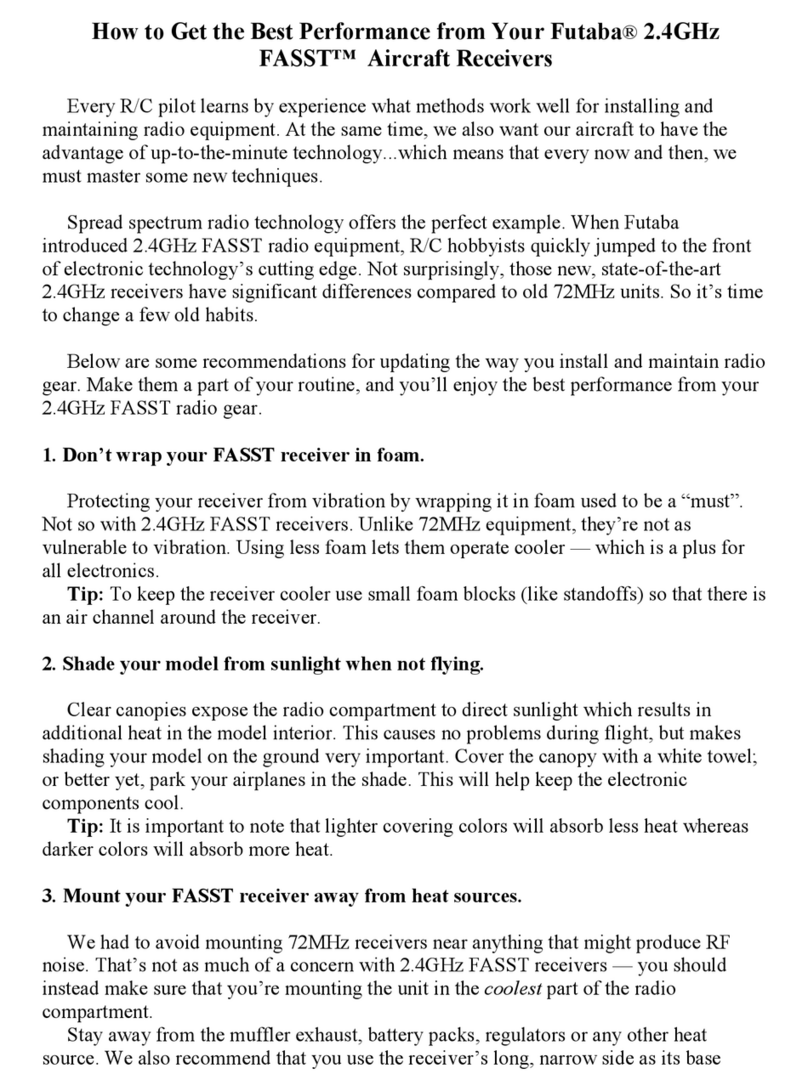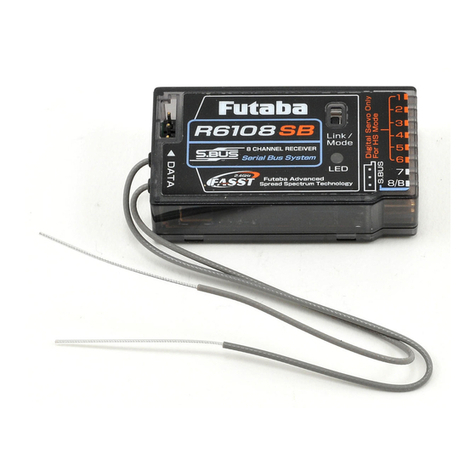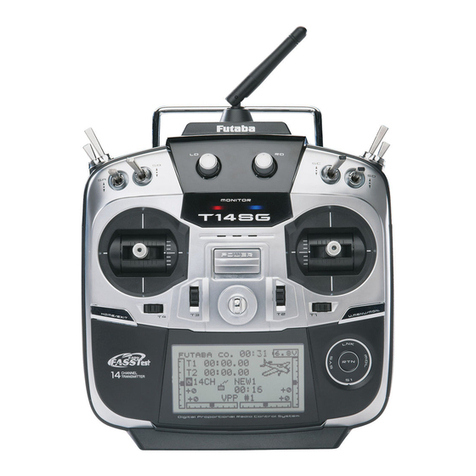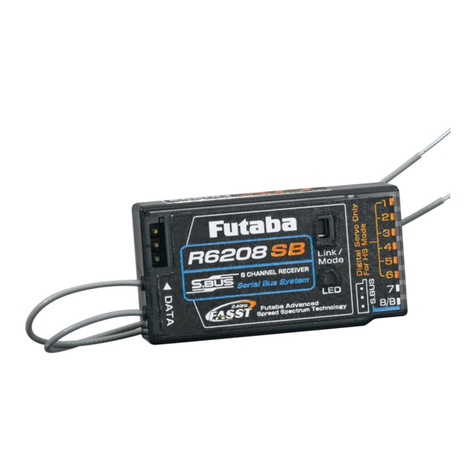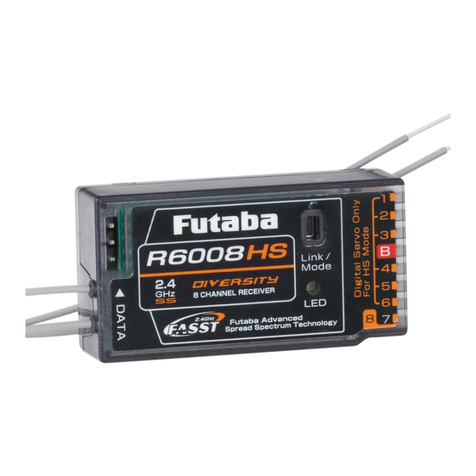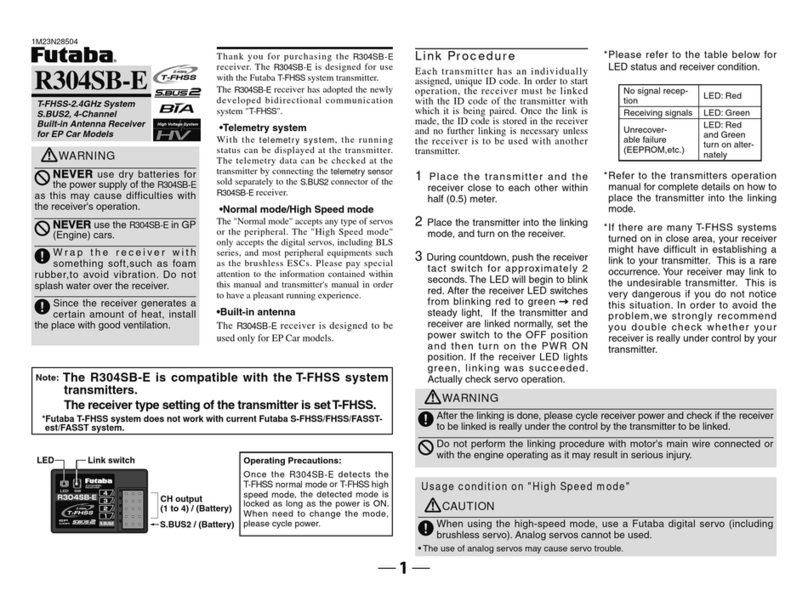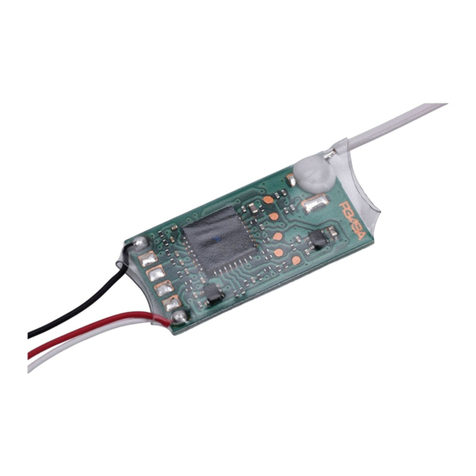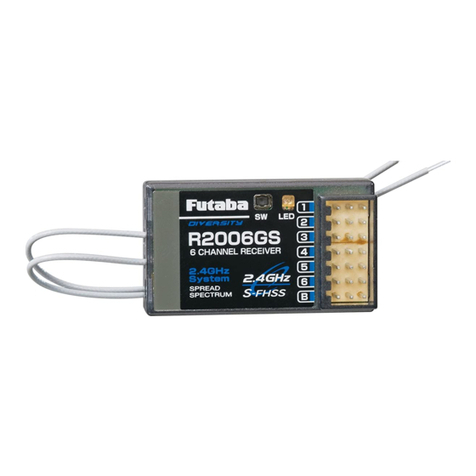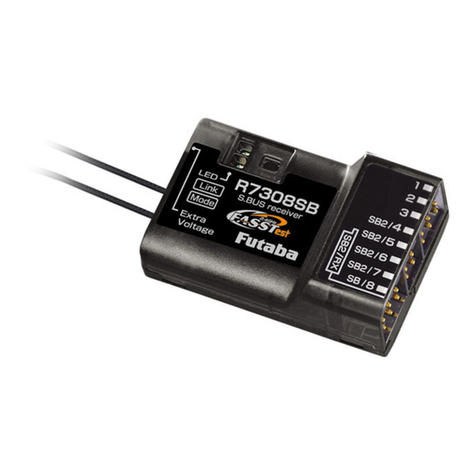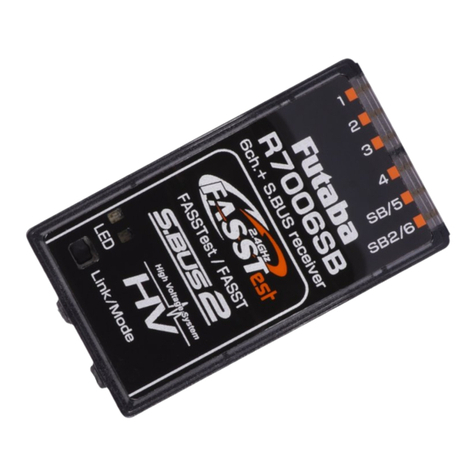
Operation Normal/High Speed Mode Select
The operation mode is set on "Normal Mode" from the factory. To
change the mode please follow the steps below.
1Turnoffthereceiver.
2PressandholdtheLink/Modebuttonandturnonthereceiver.
Pressandhold the buttonformore then1second. TheLED
willstarttoashandwillindicatethecurrentstatus.
3Releasethebutton.
4Turnoffthereceiver.
By following these steps the receiver modes can be switched back and
forth between normal and high speed modes.
0 to 1 sec. More than 1 sec.
0 sec. 1 sec.
Press and Hold
Turn on the receiver.
No function
Showing the CURRENT
mode with blink.
Red Blink = Normal
Green/Red Blink =
High Speed
Solid as the mode changed.
Red Solid = Normal
Green/Red Solid = High
Speed
(Become Red after
1second)
(Function)To change the mode between
Normal and High Speed
(LED
Status)
Please check the operation mode by observing the LED when turning on
the receiver. The best way to conrm the mode you are on is to make sure
that there are no other
FASST
transmitters turned on around you.
When turning on the receiver, the LED will be;
•Redwhenon"Normalmode"
•GreenandRed(makingorange)whenon"HighSpeedmode". (After2
seconds,theLEDwillchangetored.)
If there are any FASST transmitters turned on around the receiver, the
LED may show the above status, but just for a brief moment and then
change to the status indicated in the "LED indication" table below.
How to Set the Operation Channel
It is possible to choose the operation channel mode of the port 1 and 2
from 7 setting groups.
1Turn onthe receiver. (At this moment, the transmittershould
beoff.)Then, ensure theLEDis lit inRED or ashinggreen
light.
2PressandholdtheLink/Modebuttonmorethan5seconds.
3Releasethebutton whentheLEDblinksREDandGREEN
simultaneously.
4Thereceiverisnowinthe "OperationCHSet" mode. At this
moment,theLEDindicatescurrentsetstatusthroughashing
apatternthatcorrespondstotheCHgroup.
*Cannot exit this CH setting mode before the operation mode is xed.
**See the below table that shows correspondence between "CH group" and way
of ashing LED.
***Default CH mode is "Group 1".
5By pressing the Link/Modebutton,theoperationCHisswitched
sequentiallyas"group1""group2""group3"....
6Theoperation modewillbesetby pressingtheLink/Mode
buttonmorethan2secondsatthedesiredCHgroup.
7Releasethebutton whentheLEDblinksREDandGREEN
simultaneously.Afterreleasingthebutton,theREDand
GREENLEDarelit1secondsimultaneously.Then,the
operationCHisxed.
8 After conrming the operation CH mode is changed, turn off
andbackonthereceiverpower.
*The “Operation CH Set” mode cannot be changed during the receiver
communicates to the transmitter.
FUTABA CORPORATION
1080 Yabutsuka, Chosei-mura, Chosei-gun, Chiba-ken, 299-4395, Japan
Phone: +81 475 32 6982, Facsimile: +81 475 32 6983
©FUTABA CORPORATION 2012, 4 (1)
LED Indication
Green Red Status
Solid Solid Initializingwhenon"HighSpeedmode"
Off Solid No signal reception
Solid Off Receivingsignals
Blink Off ReceivingsignalsbutIDisunmatched
Alternate blink Unrecoverableerror(EEPROM,etc.)
CH group table
CH group LED blink Port 1 Port 2
group 1 Red 1time CH1 CH2
group 2 Red 2time CH1 CH4
group 3 Red 3time CH2 CH4
group 4 Green 1time CH1 CH5
group 5 Green 2time CH2 CH7
group 6 Green 3time CH4 CH8
group 7 Red/Green 1time CH11 CH12
group 8 Red/Green 2time not used not used
group 9 Red/Green 3time not used not used
※Initial setting is group 1.
※The groups 8 and 9are not usually used.
※3CH port and S.BUS port never change.
R6303SB
[Example:ConnectingGYA431toGroup3]
(GYA431isusedfortheaileronofanairplane)
CH4
Rudderservo
CH6
2ndAileronservo
CH2
Elevatorservo
Port1
Port2
S.BUS
3/B CH1
Aileronservo
Battery CH3
Throttleservo
GYA431
HUB
When using the R6303SB Receiver with the
GYA430, 431 and CGY750
The following table corresponds to the gyro's functions. A port can be
used effectively. The servo which a gyro controls is connected to a gyro.
* Please refer to the description of each gyro manual.
S.BUS gyro group table
Gyro control CHCH group
Rudder group 1
Elevator group 2
Aileron group 3
Elevator+Rudder group 4
Aileron+Rudder group 5
Aileron+Elevator group 6
Aileron+Elevator+Rudder
or CGY750 group 7
When S.BUS is used
* Set the channel of S.BUSservosbyusinganSBC-1channelchanger,CIU-2
USBserialinterfaceortheprogrammingsoftwareinthe18MZ transmitter.
* Can also be used together with conventional servos. However, conventional
servos cannot be used by the S.BUS output.
* When using servos with a remote battery pack, use S.BUS Hub with Cable
(2-way/remote battery pack use).
Please refer to the instruction manual of S.BUS Hub with Cable (2-way/re-
mote battery pack use) for the connection method.
*Turn on the power in transmitter→receiver order. In addition, always check
the operation of all the servos before ight.
*Do not insert or remove the servo connector while the receiver power is ON.
What is S.BUS?
S.BUS is different from conventional radio control systems in that it
uses data communication to transmit control signals from the receiver
to a servo, gyro, or other S.BUS compatible devices. The S.BUS
devices only execute only those comands for there own set channel.
This is why a single signal can be used to connect multiple servos.
